Automatic Doors
Our range of automatic doors are designed to open and close without the need for human intervention, providing convenience and efficiency in a variety of environments ranging from commercial offices to hospitals, schools and more.
Automatic Doors for enhanced accessibility, increased efficiency and improved safety in buildings across all sectors.
Automatic doors, also known as “auto doors,” are modern engineering marvels that have seamlessly integrated into our daily lives. They’ve become an essential part of modern society, playing an important role across a range of sectors and industries including healthcare, education, residential, and commercial.
Utilising sensors and automated technology to open or close automatically when they detect the presence of people or objects in their proximity, automatic door systems enhance accessibility, increase efficiency and improve safety.
Automatic Door solutions are commonly used in entrances to buildings, corridors, and public areas with high traffic to create seamless and user-friendly access points.
Automatic Door Solutions
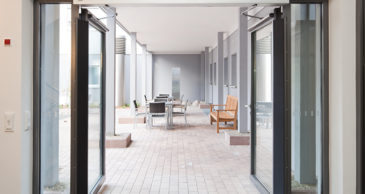
Swing Doors
A wide range of manual and automatic swing door operators, EN1154 & EN16005 compliant, CE marked, with most Certifire approved.

Revolving Doors
Reliable, low maintenance, and high performing automatic revolving door entrance systems. Supplied, installed & maintained.
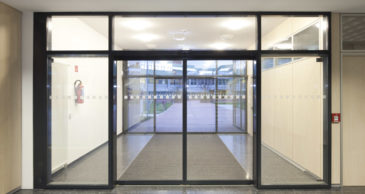
Double Leaf Automatic Doors
A range of double leaf automatic sliding and swing doors designed for installation and integration into both new and existing structures.
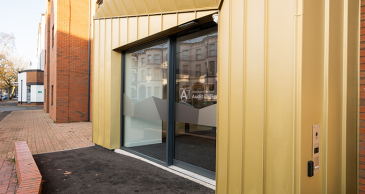
Single Leaf Automatic Doors
A range of single and double option automatic sliding doors designed for installation and integration into both new and existing structures.

Automatic Sliding Doors
A range of single and double option automatic sliding doors designed for installation and integration into both new and existing structures.
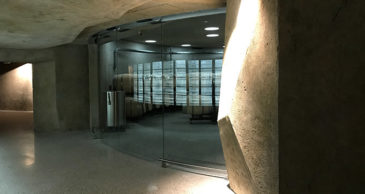
Curved Sliding Doors
Customisable curved automatic sliding door systems with options including semi-round, round-airlock, oblong airlock, outside curved or inside curved.
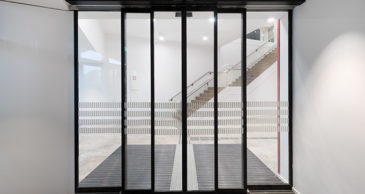
Telescopic Doors
Automatic telescopic doors available as multi-leaf systems, with profile options including thermal bridging and all-glass. Ideal for areas where space is limited.
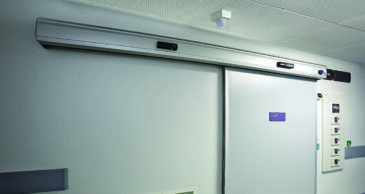
Hermetically Sealed & Cleanroom Doors
Our Hermetically Sealed & Cleanroom Door range offers a complete door set solution combining clean room door, operator and controls, and a bespoke sealing system.
Features and Benefits of our Automatic Doors
The way people move through different spaces, and enter and exit buildings, has been revolutionised by automatic door systems. Whilst, the primary function of these automated doors is to facilitate easy and convenient passage, their cutting-edge technology, and creative design provide many additional benefits that satisfy a range of energy efficiency, and safety requirements, and improve the user experience in general.
Accessibility: Our automatic door solutions make it easier for people with mobility issues, such as wheelchair users or people carrying heavy loads, to get around. They promote accessibility and inclusivity by allowing everyone to enter and exit a building easily
Safety: The technology in our automatic door systems allows them to avoid collisions by sensing people in their path and ensuring that doors open and close smoothly. This reduces the likelihood of accidents and injuries and improves the safety of your building.
Energy Efficiency: Our automated doors save energy by reducing heat or cool air loss, making them an environmentally friendly option. They lower energy costs by maintaining consistent indoor temperatures.
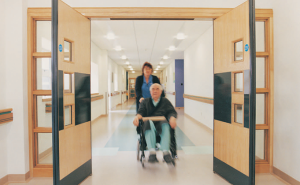
Types of Automatic Doors
We supply a range of automatic door solutions including automatic sliding doors, revolving doors, telescopic doors, hermetically sealed doors and curved sliding doors. These automatic door systems can differ in configuration, usage and size all depending on the specific needs of the building.
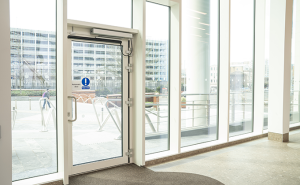
Single Leaf Automatic Doors
Our single leaf automatic doors consist of only one door panel meaning they are better suited to narrow openings the likes of which are found in retail shops, offices and houses. Another space saving feature of a single leaf automatic door is that they typically open in one direction, (inward or outward) or slide to the side when activated.
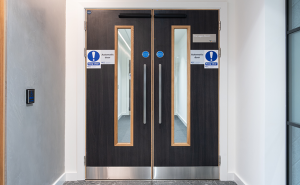
Double Leaf Automatic Doors
Our double leaf automatic doors, also commonly referred to as bi-parting doors, are better suited to wider entrances such as those found in large commercial buildings, hospital entrances and airports. Double leaf automated doors consist of two panels that open and close simultaneously usually in the centre with both panels moving away from each other. providing a wider and more accessible entrance to facilitate high levels of traffic and users who require disabled access.
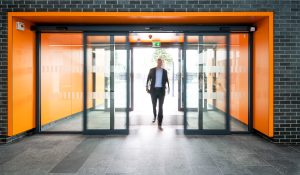
Sliding Automatic Doors
We supply a range of different types of automatic sliding doors which are used across several sectors. Whether it’s a hermetically sealed sliding door for a hospital or a curved sliding door for a residential project we work with you to create the best solutions for your building. We can offer solutions from an array of word leading brands in sliding door automation to suit your specific requirements in weight capacity, spatial constraints, height restrictions, location, perceived usage, aesthetics, activation and access requirements, and door leaf type.
Automatic Doors FAQs
Find the answers to the most frequently asked questions about automatic door systems, and learn how choosing from our range of Automatic Door Solutions can improve the accessibility, energy efficiency and safety of your building project.
Automatic doors, also known as auto doors, are doors that open and close without the need for human intervention. Instead, these doors are equipped with sensors or automated technology. They have become a common feature in various settings, including healthcare facilities, educational institutions, residential buildings, and commercial establishments.
At the heart of all our automatic door solutions is a meticulously designed door system made up of various essential components. These components work together to ensure a smooth and reliable operation. Sensors detect the presence of people and help the door to open and close smoothly as required. Control panels, motors, and gears coordinate these movements, resulting in a responsive and efficient door system.
The linear slide mechanism is crucial to the operation of many automated doors, allowing them to move fluidly. This mechanism makes use of complex engineering principles to allow doors to slide smoothly along a linear path. The linear slide mechanism ensures a quiet, reliable, and visually appealing operation by minimising friction and optimising precision. This mechanism contributes to the overall efficiency and aesthetics of automatic doors, whether in retail spaces, airports, or healthcare facilities.
Automatic door systems offer numerous benefits. They enhance accessibility by providing a seamless and user-friendly access point for individuals, including those with mobility issues. In addition, they contribute to increased efficiency and improved safety in buildings. Their ability to automatically detect the presence of people or objects nearby allows for convenient and hands-free operation, especially in high-traffic areas.
One of the most advantageous features of automatic door systems is how they contribute to ease of access. When people approach, doors automatically open without requiring physical contact thanks to motion sensors. Extra convenience is offered by touchless controls like keycard systems and proximity sensors. Easy access features make automatic door systems the preferred option in a variety of settings by improving user experience and addressing hygiene-related issues.
Safety is given top priority when it comes to the design and installation of our automated doors as their dependability is vital in emergency situations. Modern systems are made to recognize heat, smoke, or other fire-related indicators, and they automatically trigger the doors to close in order to stop the spread of the fire. Safety sensors also stop doors from shutting on people, guaranteeing that users are in a secure environment.
There are different types of automatic doors available, including sliding doors, swinging doors, and folding doors. Each type serves specific purposes and offers distinct advantages. For example, sliding doors are effective for two-way traffic, while swinging doors have a feature that allows them to swing open in emergencies.
The concept of automated entryways can be traced back to ancient civilisations such as Greece, where temples and theatres had large, heavy doors manipulated by ropes and pulleys.
Inventors and engineers in the nineteenth century developed early automatic door systems using mechanical methods such as counterweights and pneumatic devices. Innovation in the twentieth century such as electromagnetic sensors, resulted in significant advancements in automatic door technology. These sensors allowed doors to open automatically when human presence is detected.
Automatic doors today rely on sophisticated sensors, infrared technology, and energy-efficient components, making them highly reliable and adaptable to specific needs.
Automatic doors and power-assisted doors serve the purpose of assisting people in entering or exiting a building, but they function differently:
- Automatic Doors:
- Fully Automated: Automatic doors are doors that open and close automatically without requiring any physical effort from individuals. They typically utilize sensors (such as motion sensors, pressure sensors, or infrared sensors) to detect the presence of a person approaching the door. These doors open automatically upon detection and often close automatically after a certain delay.
- No Physical Force: Users do not need to push or pull the door to open it; the mechanism does it automatically.
- Types: They come in various types, such as sliding automatic doors, swing doors, revolving doors, or folding doors.
- Power-Assisted Doors:
- Semi-Automatic: Power-assisted doors, also known as low-energy automatic doors, require minimal physical force to open and close. They are not fully automated like automatic doors.
- Minimal Force Required: These doors are equipped with a mechanism that assists individuals in opening or closing them by reducing the amount of physical effort needed. They often have a button, push plate, or a lever that, when activated, initiates the motor to assist in opening or closing the door.
- Safety Features: They are designed with safety features to ensure that the doors open slowly and smoothly, reducing the risk of accidents.
In Ireland, regulations regarding the maintenance of automatic doors are primarily covered under the Safety, Health, and Welfare at Work Act 2005, which places a duty on employers and building owners to provide a safe working environment for their employees, visitors, and members of the public. While there might not be specific laws mandating the frequency of maintenance for automatic doors, it’s essential to ensure that they are properly maintained to meet safety standards and prevent accidents.
Regarding the maintenance requirements for automatic doors, the following tasks are typically recommended:
- Regular Inspections: Conduct routine visual inspections to check for any visible damages, wear and tear, or irregularities in the door’s operation. This might include examining sensors, door panels, tracks, hinges, and other components.
- Lubrication: Lubricate moving parts regularly to ensure smooth operation and prevent friction-related issues.
- Cleaning: Keep sensors, lenses, and other components clean to ensure proper functioning. Dust, dirt, or debris accumulation can interfere with sensors and hinder door operation.
- Functionality Testing: Test the door’s safety features, such as motion sensors, safety beams, and automatic reversal mechanisms, to ensure they are working correctly.
- Electrical System Check: Inspect electrical connections, wires, and control panels to identify and address any potential electrical issues.
